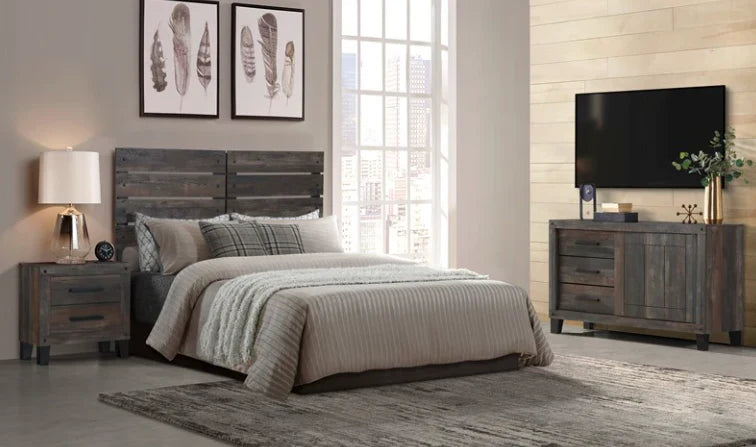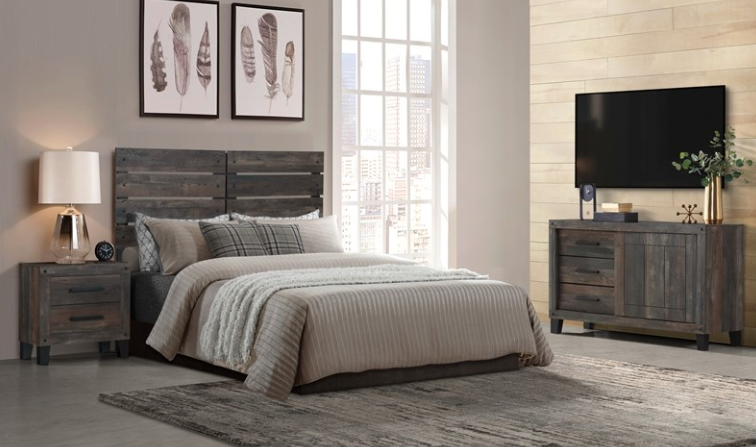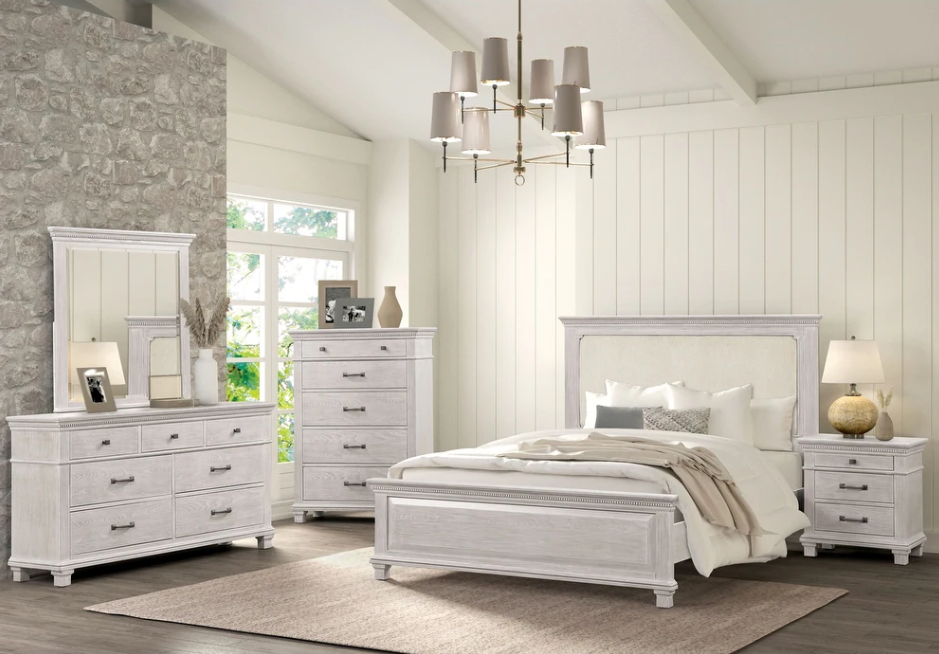
How to Mix and Match Bedroom Furniture Styles Like a Pro: Top Tips
Wondering how to mix and match bedroom furniture styles like a pro? This guide will show you easy steps to harmonize diverse pieces, creating a stylish and unified bedroom that feels uniquely yours.
Key Takeaways
-
Start with a unifying element like color or material to create harmony among mixed furniture styles.
-
Balance proportions and textures, ensuring larger items ground the space while smaller pieces add interest.
-
Layer decor elements thoughtfully to enhance the overall aesthetic of your bedroom, making it cozy and inviting.
Start with a Unifying Element
When venturing into the world of mixed bedroom furniture styles, the first step is to identify a unifying element. This is your secret weapon for creating a harmonious look amidst a variety of pieces. Whether it’s a color, material, or design theme, a unifying element ties everything together, ensuring that the room doesn’t feel disjointed.
Consider choosing neutral tones or similar hardware styles as your unifying element. For instance, pairing furniture pieces with the same finish or hardware style can significantly enhance the cohesion within the space. This subtle repetition of design elements brings a sense of unity to an otherwise eclectic mix.
Remember, the key is to start with a common thread that runs through all your furniture pieces. This could be as simple as a recurring color or as intricate as a specific material. This approach creates a focal point that guides the eye and organizes your design.
Balance Proportions and Scale
Creating a visually harmonious bedroom is all about balance. This means not only distributing colors, patterns, and textures evenly but also ensuring that the proportions and scale of your furniture pieces complement each other.
Place larger pieces like the bed or dresser to ground the room, then balance them with smaller items such as nightstands or chairs. Avoid clutter by maintaining negative space around key furniture pieces, which makes the room feel more open and airy. This strategic placement helps to balance the visual weight and prevents any one area from feeling too crowded.
Additionally, consider how the color scheme and design elements are distributed throughout the room. A balanced arrangement of decor elements on either side of the room contributes to a harmonious look. For example, if you have a bold-patterned rug on one side, balance it with a similar visual weight on the opposite side, such as a large piece of art.
Incorporate Different Textures

Textures are the unsung heroes of bedroom design. By incorporating a variety of textures, you can add depth, visual interest, and a cozy feel to your space. This approach is crucial when mixing and matching bedroom furniture, as it softens contrasts and creates a layered look.
Think about combining different materials like smooth metal frames, woolly blankets, and shaggy rugs. These contrasting textures can transform a simple room into a dynamic and inviting space. A metal bed frame combined with a plush area rug and a wool throw offers a delightful mix of hard and soft elements.
Don’t shy away from experimenting with different combinations of textures. Whether it’s floral upholstery, a leather headboard, or a shaggy rug, the key is to layer these textures in a way that adds depth and interest to your bedroom. This not only enhances the visual appeal but also makes the room feel more comfortable and lived-in.
Stick to a Cohesive Color Palette

A cohesive color palette is the glue that holds your eclectic mix of furniture styles together. A consistent color scheme unifies diverse elements, creating a harmonious look.
Choose a color palette that reflects the mood you want for your bedroom. This could range from calming neutral tones to vibrant accent colors. Keeping a simplified color palette makes it easier to mix and match different furniture styles without the risk of clashing. Neutral tones provide a versatile backdrop accommodating various styles and finishes.
Repeat design elements such as color or material throughout the room to blend different furniture styles seamlessly. For example, if you have a dark wood dresser, you might incorporate other items with similar tones or metal finishes to connect the pieces and ensure a cohesive look. This repetition creates a sense of unity and balance, making your bedroom feel thoughtfully curated.
Use Statement Pieces Wisely

Statement pieces are the stars of your bedroom, and when used wisely, they can elevate the entire design. These distinctive items serve as focal points, drawing the eye and setting the tone for the rest of the room.
Choose one or two statement pieces for your bedroom, such as a boldly upholstered headboard or a vintage dresser. Place these bedroom furniture pieces centrally to ensure they are easily noticed and appreciated. For instance, a large piece of art above the bed can serve as a stunning focal point that ties the room together.
It’s important to give statement pieces space to breathe. Avoid overcrowding them with too many accent pieces, which can create visual clutter. Allowing your statement pieces to stand out maintains visual harmony and ensures these key items shine without overwhelming the space.
Mix Wood Finishes

Mixing wood finishes can add character and depth to your bedroom. The trick lies in understanding the tone and undertone of the different wood tones you’re working with. Tone refers to the lightness or darkness of the wood, while undertone is the underlying hue.
Choose a dominant wood tone and complement it with one or two subordinate tones for a harmonious look. For instance, pairing a dark wood bed frame with lighter wood nightstands can create a balanced contrast. Ensure that the wood finishes share similar undertones, such as all warm or all cool hues, to avoid clashing.
Balance the distribution of wood finishes throughout the room to prevent clustering similar tones in one area. If you have a dark wood dresser on one side, place a similarly toned piece on the opposite side to create cohesion. This thoughtful distribution helps to tie the room together and enhances the overall aesthetic.
Experiment with Different Furniture Styles

Experimenting with different furniture styles is where the fun begins. Start by categorizing furniture types, such as wood, painted, metal, and upholstered items, to simplify the mixing furniture styles process with matching furniture. This approach allows you to see how different styles can complement each other, especially when using matching furniture sets.
Start with a neutral foundation to provide a flexible base for adding diverse styles later. For instance, a neutral-colored bed frame can accommodate various bedside tables, accent chairs, and other furniture pieces. Layering textures and materials, such as cotton, wool, and metal, can create a cohesive yet dynamic bedroom environment.
Remember, the goal is to find a balance that creates a harmonious space. Mixing complementary textures and silhouettes adds depth and prevents a uniform look. For example, a modern nightstand paired with a vintage dresser can create a unique and visually appealing contrast. The key is to blend different styles in a way that feels intentional and curated.
Layer in Decor Elements
Layering decor elements is the final touch that pulls your bedroom design together. Accent pieces like rugs, art, and textiles play a crucial role in enhancing the overall aesthetic and tying together different furniture styles.
Incorporate key elements like area rugs, curtains, wallpaper, and bedding. These items add pattern, texture, and color, creating a layered and inviting space. A patterned rug can act as a foundational layer, introducing visual interest and anchoring the room.
Balance statement pieces with complementary decor and furniture to maintain visual interest. For example, if you have a bold piece of art, balance it with more subtle textiles and accessories. This approach ensures that your decor elements enhance rather than overpower the overall design.
Thoughtfully layering decor elements results in a bedroom that feels cohesive, dynamic, and uniquely yours.
Trust Your Instincts and Adjust
Ultimately, creating a personal and inviting space is the goal of mixing and matching bedroom furniture. Trust your instincts and allow your creativity to guide you. Experiment with different furniture combinations, and don’t be afraid to make adjustments as needed.
As you arrange and rearrange your furniture, pay attention to how each piece fits within the overall design. If something doesn’t feel right, make the necessary adjustments to achieve a cohesive atmosphere. This iterative process allows you to fine-tune your space until it perfectly reflects your style and personality.
Remember, there are no strict rules when it comes to mixing and matching bedroom furniture. The key is to have fun and enjoy the process of selecting bedroom furniture. Trusting your instincts and making thoughtful adjustments allows you to create a mix bedroom furniture that’s both beautiful and uniquely yours.
Shop at Mare Blu Today!
Looking to bring your bedroom vision to life? Shop at Mare Blu today for a wide variety of bedroom furniture sets that match bedroom furniture pieces, including nightstands, dressers, and bed frames available in different colors and finishes. Whether you prefer modern, vintage, or eclectic styles, Mare Blu has something for everyone, including a matching bedroom set.
Mare Blu offers competitive pricing and pre-assembled items, making it easy to find furniture that suits your budget and style. Plus, we offer delivery services within the Tri-State Area, ensuring that your new furniture arrives safely and promptly.
Don’t wait to create the bedroom of your dreams. Visit us today and discover the perfect pieces to mix and match bedroom for a stunning and cohesive space.
Summary
Mixing and matching bedroom furniture styles may seem challenging, but with the right tips and a bit of creativity, it becomes a delightful design adventure. Start with a unifying element, balance proportions and scale, and incorporate different textures to add depth and visual interest. Stick to a cohesive color palette, use statement pieces wisely, and mix wood finishes for a harmonious look.
Experiment with different furniture styles, layer in decor elements, and trust your instincts to create a personal and inviting space. Remember, the key is to have fun and enjoy the process. By following these tips, you can transform your bedroom into a stylish sanctuary that reflects your unique personality.
Frequently Asked Questions
How to design a bedroom with mismatched furniture?
To design a bedroom with mismatched furniture, focus on a neutral palette and incorporate common colors or textures among your pieces to create cohesion. Remember to accessorize thoughtfully and consider using light as a focal point to tie everything together beautifully.
Why is identifying a unifying element important in bedroom design?
Identifying a unifying element is crucial in bedroom design because it brings harmony and cohesion to the space, making sure different furniture styles work well together. This creates a more inviting and peaceful atmosphere.
How can I balance proportions and scale in my bedroom?
To balance proportions and scale in your bedroom, evenly distribute colors, patterns, and textures while ensuring there's ample negative space around key furniture pieces. This creates visual harmony and makes the room feel more inviting.
What are some examples of textures to incorporate in bedroom design?
To create a cozy and inviting bedroom, mix smooth metal frames with soft woolly blankets and shaggy rugs. This combination adds depth and texture, making your space feel warm and layered.
How do I choose a cohesive color palette for my bedroom?
To create a cohesive color palette for your bedroom, opt for colors that reflect the mood you want and stick to similar undertones. Repeating design elements like color or material will help tie everything together beautifully.
